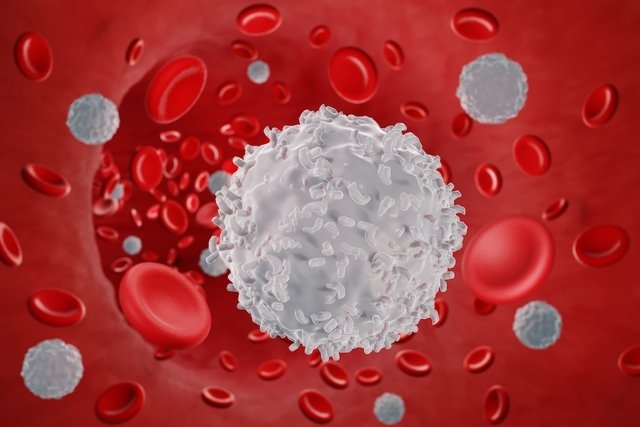Leukocytes, also known as white blood cells, are the cells responsible for defending the body against infections, diseases, allergies and colds, being part of each person’s immunity.
These cells are transported in the blood to be used whenever a virus, bacteria, or any other foreign organism enters the human body, eliminating them and preventing them from causing health problems.
The presence of high or low leukocytes in the blood may indicate that the person has an infection, stress or anemia, for example. Therefore, it is important that blood tests are carried out regularly and the result is interpreted by the doctor.

Reference values
The normal value of leukocytes in the blood is between 4000 and 11000 leukocytes/mm³ of blood in adults. However, this value may vary from one laboratory to another, and it is important that the tests are evaluated by the doctor. Understand how the leukogram is done and how to interpret the results.
Do you have questions about your exam results?
To find out if your leukocyte values are normal, enter the test result into the following calculator:
What do the results mean
Leukocytes can be high or low for several reasons, as indicated below:
1. High WBC
Increased leukocytes, also known as leukocytosis, are characterized by a value greater than 11,000/mm³ in the blood test.
- Possible causes: recent infection or illness, excess stress, side effects of medication, allergies, asthma, rheumatoid arthritis, myelofibrosis or leukemia, lymphoma and cigarette use, for example;
- What are the symptoms: are rare, but may include fever above 38ºC, dizziness, difficulty breathing, tingling in the arms and legs and loss of appetite;
In these cases, a general practitioner should be consulted to diagnose the cause of the increased leukocytes, as it may be necessary to undergo specific treatment with antibiotics or corticosteroids.
2. Low WBC
Low leukocytes, also called leukopenia, appear when there are less than 4,000 leukocytes/mm³ in the blood test. Learn more about leukopenia.
- Some causes: anemia, mononucleosis, hepatitis A and B, use of antibiotics and diuretics, poor nutrition or a weak immune system caused by HIV, leukemia, lupus or chemotherapy, for example;
- What are the symptoms: excessive tiredness, recurring infections and colds, constant fever, headaches and abdominal pain;
If this happens, it is recommended to go to your general practitioner to diagnose the cause of the disease. However, in some cases, it is normal to have low leukocytes without a serious cause, and you should just be careful to avoid flu and colds, which can happen more easily. See what symptoms may indicate low immunity.
What can be leukocytes in urine
It is normal to have leukocytes in the urine, as they are eliminated in the urine when their lifespan is over. However, during urinary infections or in situations of more serious illnesses, such as cancer, leukocyte levels in urine normally increase greatly.
Generally, high leukocytes in the urine generate signs and symptoms, such as foamy urine, fever, chills or blood in the urine, for example. In these cases, you should consult your general practitioner or a nephrologist to diagnose the cause and initiate appropriate treatment. Find out what foamy urine can mean.
Additionally, high white blood cells in the urine can also be a sign of pregnancy, especially when accompanied by an increase in the number of proteins in the urine. In these cases, you should take a pregnancy test or consult a gynecologist to avoid false diagnoses.
Bibliography
- BRAZILIAN ASSOCIATION OF LYMPHOMA AND LEUKEMIA. When to worry about low or high lymphocytes and white blood cells. Available at: <https://revista.abrale.org.br/saude/2023/01/ Quando-se-trabalhor-com-os-linfocitos-e-leucocitos-baixas-ou-altos/>. Accessed on 02 Nov 2023
- NATIONAL QUALITY CONTROL PROGRAM. Hematological reference values for adults and children. 2020. Available at: <https://pncq.org.br/wp-content/uploads/2021/04/VRH2020.pdf>. Accessed on 02 Nov 2023
- MAYO CLINIC. Low white blood cell count. Disponível em: <https://www.mayoclinic.org/symptoms/low-white-blood-cell-count/basics/causes/sym-20050615>. Acesso em 04 ago 2023
- UCSF HEALTH. WBC Count. Disponível em: <https://www.ucsfhealth.org/medical-tests/wbc-count#:~:text=Normal%20Results,or%20may%20test%20different%20specimens.>. Acesso em 04 ago 2023
- MAYO CLINIC. High white blood cell count. Disponível em: <https://www.mayoclinic.org/symptoms/high-white-blood-cell-count/basics/causes/sym-20050611>. Acesso em 04 ago 2023

Sign up for our newsletter and stay up to date with exclusive news
that can transform your routine!
Warning: Undefined array key "title" in /home/storelat/public_html/wp-content/plugins/link-whisper-premium/templates/frontend/related-posts.php on line 12
Warning: Undefined array key "title_tag" in /home/storelat/public_html/wp-content/plugins/link-whisper-premium/templates/frontend/related-posts.php on line 13



